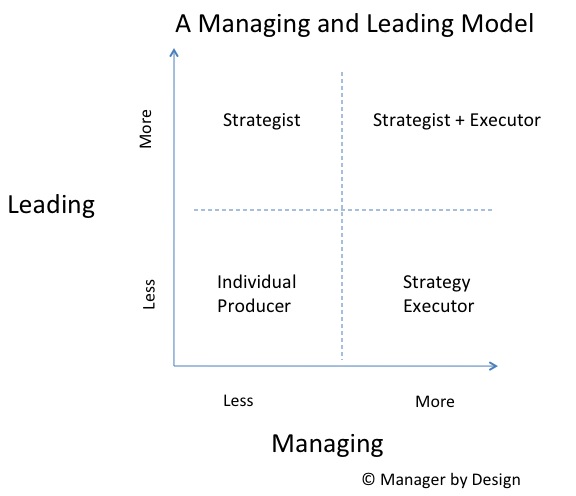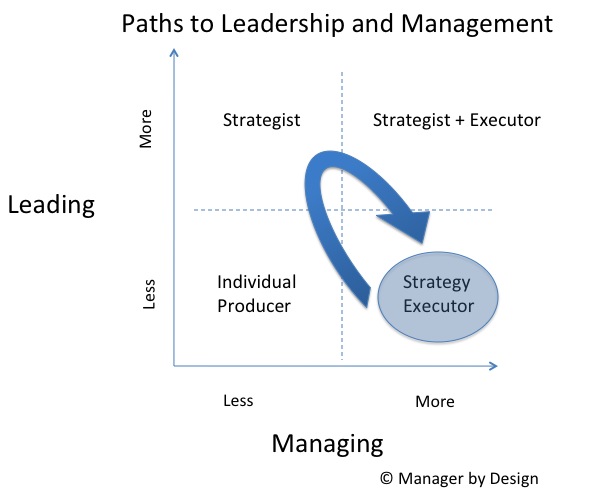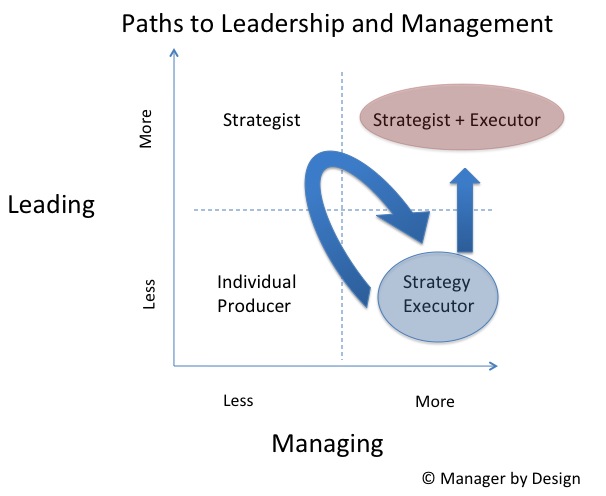Do your leaders know and articulate the organization’s strategy? Read on for a deconstruction of leadership.
The last few articles I’ve published describe some tips for helping managers – strategy executors – to better understand and articulate an organization’s strategy. But perhaps I’m getting ahead of myself here – do the leaders even know the organization’s strategy and do they articulate it?
Let’s take a look at two grids developed by the Manager by Designsm blog.
In this first one, the Leadership/Management mode, those who are leading are basically the ones setting the strategy and then take steps to roll out that strategy. That’s what defines leadership here at the Manager by Designsm blog. But what happens if you don’t have leaders who do this? If that’s the case, they are doing something else. They are in a “leadership position” but are not leading. Read more
Management Design: How to include your managers in the strategy development process and develop leaders at the same time
If your organization has a strategy, it’s probably important that your managers – the strategy executors – be able to understand, articulate, and interpret the strategy well. If not, then this is bad management design. The Manager by Designsm blog’s leadership/management model makes the distinction of managers as strategy executors and leaders as strategy developers. So it is important that the managers be able to understand, articulate and interpret the strategy well.
One good design is to include managers in the strategy development process. It looks something like this:
But this should be designed to be done smartly and not in a haphazard way. An example of being sloppy in the design of “including the managers” is through having the management team regularly sit in on leadership meetings. This is a big waste of time, and would no doubt chart as low quality meetings.
Instead, the managers’ involvement needs to have the following elements:
a) Specifically selected managers (not all managers)
b) Be focused specifically on the strategy development process (not all leadership meetings)
c) The role needs to be defined with expectations to participate included (not just sit in)
d) It needs to be articulated that managers are assisting with the strategy development process (as opposed to, say, “You’re attending the ‘Leadership Meetings’”)
e) There needs to be an end to this process so the manager can go back to managing (not a standing invitation).
As a bonus, if the strategy development process is an involved one, the managers involved would be temporarily relieved of their duties as “strategy executor” manager, with the understanding that they will go back to this role.
In this process, not only will the manager become better at managing, in that she (and her employees) will be able to articulate and interpret the strategy better, but she is also is aware of the strategy development process as a specific process, allowing her to become a better “leader” in addition to being a better manager.
Perhaps that manager will someday make a transition to being a “leader” and will be able to do – when in that leadership position — the following things:
- Articulate that there is a strategy development process
- Describe what that process is
- Replicate it and improve upon it when in the role of strategy developer
- Include the managers in the process
All of this while doing work that assists the current organization needs, and done on the job and not in a separate, abstracted training class. So the “leadership development” of the manager would look something like this:
The manager learns how to manage (strategy execution) and then learns how to lead (set strategy) and understand the difference between these actions, versus conflating these myriad of actions all as “leadership.”
As an extra bonus to including a manager in the strategy development process, the strategy itself will likely be better, as she can provide the needed perspective from the “strategy executors” on what they need to execute the strategy, and whether the strategy is going to work. As a double extra bonus, she will be to assist with the strategy implementation to other managers, assist with the ongoing interpretation to the other managers, all things that seem to assist with the current needs of the organization. In short, this is “leadership development” while doing the current job better.
The alternative I have seen is to have leadership development happen external to the job – -usually through a leadership development class or series of classes. These are effective at introducing the concepts, but do not allow for immediate applicability. This time delay will usually mean limited (if at all) application of the concepts. If you need classes at all, a better design would be to have the “strategy process” be taught to the manager (strategy executor) just prior to participating in the strategy development process.
Does your organization include the managers in the actual strategy development process? Or does it rely on developing its leadership through either classes or “sink or swim” methods?
Related Articles:
Management Design: The Designs we have now: The paths to management and leadership
Management Design: An alternative path to management and leadership: Loop in and out
Management Design: Structure and Feedback in a focused area of leadership
A model to show the difference between managing and leading
Do your managers know the strategy of your organization?
Tips for how your managers can better execute strategy
Tips for how your managers can better understand your strategy
How do managers learn strategy?
Management Design: A proposed design so that new managers embrace learning management skills




